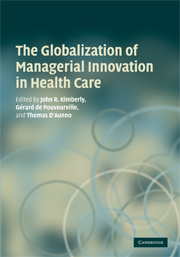Book contents
- Frontmatter
- Contents
- List of figures
- List of tables
- List of contributors
- Acknowledgements
- Introduction
- 1 Origins of DRGs in the United States: A technical, political and cultural story
- 2 Casemix in the United Kingdom: From development to plans
- 3 Casemix implementation in Portugal
- 4 From naïve hope to realistic conviction: DRGs in Sweden
- 5 Casemix in Denmark
- 6 DRGs in France
- 7 Introduction and use of DRGs in Belgium
- 8 DRGs in Germany: Introduction of a comprehensive, prospective DRG payment system by 2009
- 9 Casemix in Switzerland
- 10 The first decade of casemix in Italy
- 11 Casemix development and implementation in Australia
- 12 Diagnosis procedure combination: The Japanese approach to casemix
- 13 Casemix in Singapore
- 14 Experiences with the application of the DRG principle in Hungary
- 15 Casemix systems – past, present, and future: The Canadian experience
- 16 Conclusions: The global diffusion of casemix
- Index
- References
5 - Casemix in Denmark
Published online by Cambridge University Press: 24 February 2010
- Frontmatter
- Contents
- List of figures
- List of tables
- List of contributors
- Acknowledgements
- Introduction
- 1 Origins of DRGs in the United States: A technical, political and cultural story
- 2 Casemix in the United Kingdom: From development to plans
- 3 Casemix implementation in Portugal
- 4 From naïve hope to realistic conviction: DRGs in Sweden
- 5 Casemix in Denmark
- 6 DRGs in France
- 7 Introduction and use of DRGs in Belgium
- 8 DRGs in Germany: Introduction of a comprehensive, prospective DRG payment system by 2009
- 9 Casemix in Switzerland
- 10 The first decade of casemix in Italy
- 11 Casemix development and implementation in Australia
- 12 Diagnosis procedure combination: The Japanese approach to casemix
- 13 Casemix in Singapore
- 14 Experiences with the application of the DRG principle in Hungary
- 15 Casemix systems – past, present, and future: The Canadian experience
- 16 Conclusions: The global diffusion of casemix
- Index
- References
Summary
The Danish health care system
The Danish health care system is characterized by free and equal access to health care services. This principle has the same high priority regardless of the party in office. Free and equal access to health care services and universal coverage go hand in hand with a strong determination to control costs. Within the last fifteen years, the freedom to select the hospital of one's choice has also become a very important part of the health care system.
The health care system in Denmark is mainly publicly financed through taxes, and is decentralized, with three administrative levels: state, county and municipality. The state's task in health care provision is, first and foremost, to initiate, coordinate, advise, and legislate. The counties are responsible for providing health care services within the limits set by the state. The municipalities are responsible for district nursing, public health care, school health care, and child dental treatment.
The provision of health care services by municipalities and counties is negotiated every year in the national budget negotiation. The budget negotiation takes place between the government on the one hand, and the Danish regions (counties) and Local Government Denmark (LGDK) on the other. Agreements are typically in the form of recommendations for local and country tax rates and agreements on injecting capital into specific health care areas or projects, such as cancer treatment or waiting times. Introduction of activity-based financing has also been agreed on in budget negotiations.
- Type
- Chapter
- Information
- The Globalization of Managerial Innovation in Health Care , pp. 92 - 115Publisher: Cambridge University PressPrint publication year: 2008



